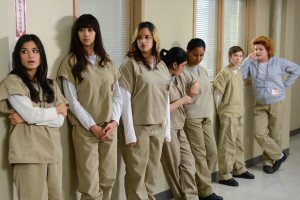Annadele Herman
I have a confession: I’m a closeted Orange is the New Black fan – a voyeurist who peers in for ten minutes on the rare occasion that my toddler is sleeping or I find myself alone in the bathroom. Last week, I finally made it to the third episode of the third season when Alex tells a new corrections officer: “I get it, you think you’re one of the good guys. But guess what, we all think that we’re the good guys.”
The shows isn’t perfect. Even the show’s inspiration, Piper Kerman, tells the media that >>the show is often unrealistic and, particularly damning, it sometimes awkwardly pokes fun at mental health issues. But like many of the profound things uttered by inmates during the course of their day, Alex’s lesson gave me pause. Are the memories of the inmates in the show accurate representations of the lives of women prior to incarceration? If the rest of us were pushed that often and that harshly to the outside, would we also, even in just a moment of weakness, just give up on coloring in the lines?
So I searched for answers in >>Wally Lamb’s compilation of essays, I’ll Fly Away , written by incarcerated women. My heart is laden with the burden of their memories. Babies were left to die in a trailer and found with maggots thriving off of their flesh. A child was methodically punished with cigarette burns or a hot iron, his cries for leniency ignored. Parents enabled or were indifferent to childhood sexual abuse. Stories like these don’t leave you to have to imagine the road that follows: dulling pain with substance abuse, alienation, and the toxic relationships that seem to find those who have been taught from childhood that they have little worth. The same lessons are learned again inside a costly system of timeout designed to demean, belittle, and, often, re-victimize: our federal and state prison system. When a criminal record usually means a lifetime of underemployment, poverty, and stigma, any criminal record is, in a sense, a life sentence.
We live in a country addicted to over-criminalization and mass incarceration. The United States incarcerates its citizens at six times the rate of other developed countries. We hold one third of all female prisoners in the world. The state of North Carolina alone >>holds more women prisoners than El Salvador, a country that >> imprisons women for having miscarriages .
The rate of incarceration is >>rapidly increasing at a shocking clip, faster than the rate of incarcerated men by more than 50%. In 1980, there were 26,378 serving time. By 2014, that number had risen to over 215,000 – a climb of more than 700%. The fastest growing prison population? Women of color.
So what’s going on here?
One theory is that women were collateral targets in the “war on drugs” that spanned three decades and left nonviolent prisoners, some serving life sentences, in its wake. The statistics bolster this idea – 24 percent of incarcerated women are imprisoned on drug charges as opposed to 15 percent of men.
Over coffee with a friend recently, he peered at me over his latte as we were discussing this, hesitated, and then declared that I’d be setting back the feminist movement if I wrote about this. Perhaps this rise in incarceration of women is a good thing – a sign that our court system began to see women as being just as culpable as men and is now just as likely to hold them responsible for their choices. In short, they were merely “catching up.”
But there’s no denying that incarcerated women differ substantially from men. Over 70% of incarcerated women have been the victims of incest and sexual violence. Over half are incarcerated on nonviolent drug or property related charges. The majority of men are incarcerated for violent offenses. At an average cost of incarceration of $83.89 a day, incarcerating women who may be better served by counseling, substance abuse treatment, and other social services is costing taxpayers $6.6 billion a year.
And a majority of these women are mothers. The consequences to children are profound. According to a >>2015 study , nearly half of all U.S. children have at least one parent with a criminal record. In turn, they’re more likely to experience poverty and household instability.
The good news? The tides are beginning to turn. President Barack Obama commuted the sentences of 61 nonviolent drug offenders in March, bringing the total during his presidency to 248. Initiatives like the >>Fair Chance Business Pledge lower barriers to employment for those with a criminal record. Community organizations like >>Benevolence Farm , nestled in Graham, North Carolina, provide a place for women leaving prison to live, work, and nurture themselves and their community.
The problems are many and complex. They start long before women enter prison and continue long after they leave. Perhaps a good start is a society full of people whose first instinct is to pull up a chair, listen, and learn.


There are no comments
Add yours